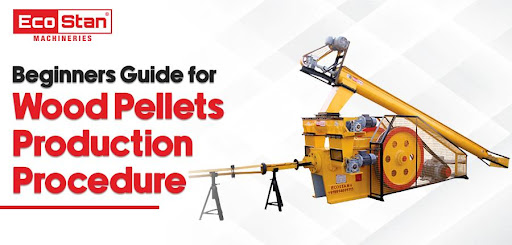Introduction to wood pellets
A wood pellet is a cylindrical material, manufactured from waste wood products such as sawdust, shavings, bark, slabs, and pieces. You can use them in stoves and boilers as a fuel or heating source.
Wood pellets are an excellent alternative to fossil fuels for home heating, cooking, and industrial purposes. They are a renewable energy source that burns cleaner than coal and are crucial as a substitute fuel in power plants and residences.
The wood pellet is a substitute for coal and oil in Europe since the 1980s. They are also utilized particularly as an alternative to natural gas and propane in various regions of the earth, where such fuels are expensive or difficult to transport.
Making wood pellets is an excellent method to utilize unwanted yard trash while also starting a successful side company. The Wood pellet machine is used in making high quality wood pellets.
Making Of Wood Pellets
Wood pellet Machine is a simple and quick way to receive the comfort and warmth of a wood-burning stove without the clutter. Making your pellets is a sustainable option that offers a renewable, biodegradable fuel supply for your fireplace, stove, or another heating device.
You’ll save money on your heating expenses while also helping the environment! Even better, the procedure is simple and takes very little time.
Here’s what you should know.
1.Prepare The Materials For Making Wood Pellets
To create a Wood pellet you must first prepare the necessary components. Pellets can be made from cubic pieces of round wood, lumber logs, timber slabs, timber branches, or sawdust and chips. You should select materials depending on cost and availability.
To save money on drying the little bits of material, use smaller pieces of material for manufacturing pellets. You should utilize dry materials for your wood pellets as much as possible because they are quick to dry and cost less than wet materials.
2. Use A Wood Chipper machine To Chip The Logs Into Small Wood Chips With Diameter
The second stage in manufacturing wood pellets is to utilize a Wood Chipper machine to break down all of your material into wood chips. The wood chipper is a crucial component of the machine that makes wood pellets because the smaller the size of the material, the easier it is to transform into pellets. These chips should be 3-5cm in diameter when finished. The initial crushing step reduces the size of your resources so that they may easily pass through a hammer mill. There is no need to use a wood chipper if your material is already sawdust (as opposed to huge chunks of solid wood).
3. Use The Hammer Mill To Reduce The Size Of Wood Pellet
The third step in producing wood pellets is to further reduce the size of wood chips into sawdust with a diameter of (3-5) mm. This is the second crushing stage, in which the chips are reduced to smaller particles of sawdust that should be carefully sorted for direct use in pellet manufacture. You can change the diameter of the holes in the hammer mill to o regulate the size of the sawdust.
4. Dry The Saw Dust In A Rotary Dryer
Next, dry the sawdust in a rotary drier until it is 8-12% moisture content (if the sawdust already has 8-12% moisture content, omit this step).
To produce consistent quality wood pellets the moisture percentage of the raw material should be between 8 and 12% (no more than 12%).
5. Use A Pellet Machine To Press Your Material Into a Wood pellet
The Pellet Mill is the heart of the pellet-making process. Feed the dried sawdust into the hopper of the pellet machine, and the sawdust will be pressed by revolving rollers powered by an electric motor. The wood pellets will be squeezed out of the ring die holes and sliced with spinning knives to a predetermined length.
6. Filtering at the end
After cooling, the final screening begins. Because you will be delivering pellets to your consumers, be sure they have the right shape, size, and finish.
Remove any wood pellets that are uneven, broken, or distorted. If you don’t want to squander them, sell them cheaply at your local market.
7. Coll Down The Finished Pellets And Pack Them For Storage
After the raw material has been pelletized into wood pellets, it must be quickly cool. Cooling newly created wood pellets can aid in the prevention of fire threats. It also keeps them dry, preventing them from rotting or decaying over time. You may chill your wood pellets with a counter-flow cooler. All your efforts may be for naught if you do not properly store and pack your wood pellets.
You can load your pellets in compact bags or containers. Make certain that they are made of high-quality plastic. Airtight, stackable, and waterproof bags are required.
You can invest in automated packaging equipment and a Wood pellet machine if you meet the high demand for wood pellets. This equipment is used to reduce time and labor on several big and medium-sized pellet manufacturing lines. During the summer, the demand for wood pellets naturally declines. As a result, you must construct a proper wood pellet storage location.
Keep your pellets in a dry area at all times. They should not catch fungus that thrives in moist environments. Packaging the cooled pellets in moisture-resistant bags or containers will also assist to keep them from absorbing water from their surroundings.
What Are The Ingredients In A Wood pellet?
Wood pellets are manufactured from many types of wood sawdust, including hardwood and softwood. Wood pellets contain the chemicals cellulose, hemicellulose, lignin, and extracts. Lignin works as a cellulose binder. As a result, no artificial binder is required to create wood pellets. The Wood Chipper machine is also an important part of making wood pellets.
The fundamental components of the Wood pellet do not include any binders or chemicals; only the forms are modified by the pellet machine, which is a physical process. The density will shift to 800-1300kg/m3 after pelletizing, extending the burning period. As a result, wood pellets can be a cleaner and more environmentally friendly fuel than coal, with a growing market share in global energy consumption.
Conclusion
A single DIY Wood pellet Machine is typically not insufficient for making wood pellets at home, because you are unlikely to have raw materials suitable for creating pellets. The moisture level of raw materials for creating wood pellets should be between 10% and 18%, and the size should be smaller than that of holes on flat dies. Flat die hole sizes are frequently 6mm, 8mm, and 10mm. As a result, raw materials must be 3-5mm in size. The pellet business gets an estimated 85% of its fiber from byproducts of sawmills and other related sectors. We hope this post is helpful for you to know about the process of wood pellets making.








